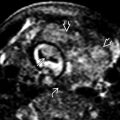KEY FACTS
Terminology
- •
70% dizygotic : 2 ova fertilized by different sperm; therefore, all are dichorionic
- •
30% monozygotic : Single ovum fertilized by single sperm, which then divides to produce twins
- ○
30% dichorionic, 60-65% monochorionic diamniotic
- ○
5-10% monoamniotic, < 1% conjoined
- ○
Imaging
- •
Dichorionic 1st trimester: Thick echogenic chorion completely surrounds each embryo
- ○
2 amniotic sacs, 2 yolk sacs (YS)
- ○
- •
Dichorionic 2nd/3rd trimester: Twin peak sign with wedge of chorionic tissue extending from placenta into base of intertwin membrane
- ○
Thick intertwin membrane, 2 separate placentas
- ○
- •
Monochorionic 1st trimester: Single thick chorion surrounds both embryos
- ○
Diamniotic: 2 YS, 2 amnions, 1 around each embryo
- ○
Monoamniotic: 1 YS, 1 amnion surrounds both embryos
- ○
- •
Monochorionic 2nd/3rd trimester must be same sex with single placental mass
- ○
Diamniotic: Thin membrane, T sign of membrane perpendicular to placenta
- ○
Monoamniotic: No membrane, cord entanglement
- ○
Scanning Tips
- •
Use transvaginal US in 1st trimester to document chorionicity and amnionicity as chorionicity determines prognosis
- •
Look for placenta/vasa previa, marginal/velamentous cord
- •
Monitor growth at least monthly
- •
Check fluid volume every 2 weeks in monochorionic twins to monitor for twin-twin transfusion
- ○
If diamniotic: Maximum vertical pockets on either side of membrane
- ○
Must rely on bladders/Doppler in monoamniotic
- ○
- •
Careful search for anomalies; increased risk in all twins
 and 2 thick layers of chorion
and 2 thick layers of chorion  . The placentas
. The placentas  are separate.
are separate.
 , each surrounding an embryo
, each surrounding an embryo  . The twin peak sign and thick membrane will develop as a result of apposition of the adjacent chorions
. The twin peak sign and thick membrane will develop as a result of apposition of the adjacent chorions  . This case illustrates the ease of determining chorionicity with vaginal sonography.
. This case illustrates the ease of determining chorionicity with vaginal sonography.
 barely visible inside the echogenic chorionic sacs. The twin peak sign is now visible
barely visible inside the echogenic chorionic sacs. The twin peak sign is now visible  where the broad-based triangle of chorion extends into the thick membrane. This is also sometimes called the lambda sign.
where the broad-based triangle of chorion extends into the thick membrane. This is also sometimes called the lambda sign.

 . There is a single placenta
. There is a single placenta  and a single chorionic sac
and a single chorionic sac  .
.
Stay updated, free articles. Join our Telegram channel

Full access? Get Clinical Tree








